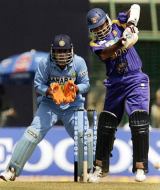
|

The move to No. 5 has worked for Marvan Atapattu, lending stability to the middle order and paving the way for aggression at the top
© Getty Images
|
|
Sri Lanka breathed a huge sigh of relief on Sunday night. The ignominy of a seven-match whitewash, which loomed so ominously after their series-losing defeat in Pune, was avoided and India's momentum finally checked. It came too late for this series but a turnaround was utterly essential before December's Test series.
Crucially, after a hapless two weeks since their arrival, Sri Lanka were finally the lucky recipients of some good fortune. Marvan Atapattu won an important toss, ensuring India's bowlers would have to contend with heavy dew in the evening. It helped too that India were in charitable mood, unbelievably resting Sachin Tendulkar, Harbhajan Singh and Irfan Pathan.
Sri Lanka arrived in India as the in-form team and the No 2 team in the world, but after Pune and four heavy defeats confidence was haemorrhaging. India's swashbuckling, high-intensity cricket had left them shocked, perplexed and edgy. India, though, mindful of the need to manage their players carefully during a long season, provided them with a window of opportunity to lift themselves off the floor.
Especially pleasing for Sri Lanka was the clinical manner in which Tillakaratne Dilshan and Russel Arnold finished off the match. When Mahela Jayawardene, guilty of not backing up properly, was run out at 155 for 5, Sri Lanka looked poised to squander another winning opportunity. But the conditions were ideal for batting with the ball skidding on to the bat and India's spinners unable to grip a slippery seam. Arnold, wearing his normal poker face, manoeuvred the ball expertly into the gaps while Dilshan, bristling with energy, cracked the ball around freely for his match-winning 81 from 63 balls.
Dilshan is hugely talented but has been a frustrating serial underachiever in one-day internationals, averaging a poor 24.51 from 64 matches before this game. He does occupy a particularly difficult position in the batting order, languishing at No 5 and No 6, but such a meagre return for such obvious talent is unacceptable for a team with world-champion aspirations. Hopefully, two fifties thus far in the series will help speed-up the transition from a player of promise to a reliable performer.
Farveez Maharoof's starring role as Super Sub could also prove important. His bowling had been carted in the first four games and his confidence severely dented. To his huge credit he has showed great heart throughout and his game has not been derailed by the ferocity of India's strokeplayers. Fast bowling allrounders are a precious breed and Sri Lanka desperately need him to gradually mature into a pivotal player. Today he showed the necessary fight to learn in the harshest of classrooms, his 4 for 20 preventing India from scoring 300 plus.
Sri Lanka will now look forward to the sixth ODI with fresh optimism, believing that they are slowly rediscovering their form and therefore capable of overcoming a reinvigorated and youthful Indian team. However, one victory does not solve all their problems. India have graphically exposed problems within the team that need to be urgently addressed over the coming months.
The most pressing issue concerns Sanath Jayasuriya's role within the team. While he remains an immensely valuable player and a potentially crucial cog during Sri Lanka's 2007 World Cup campaign, it is becoming increasingly obvious that his peak has passed as an opening batsman and that he could add greater value to the team as a vastly experienced allrounder batting at No 6 or No 7.
The entire top order needs to be reassessed with a view to increasing the responsibilities of Kumar Sangakkara and Jayawardene in the top four. These two are now Sri Lanka's impact players; the batsmen who can make best use of the extended fielding restrictions during the Power Play experiment and go on to score large match-winning hundreds. Jayasuriya's demotion also provides Upul Tharanga, an exciting talent, a chance to bed down at the top of the order.
Atapattu's position at No 5 has worked well so far in this series and it is an experiment worth continuing with, filling the middle order with a player of greater experience who can tick the innings along during the middle overs. The time may have also come for Dilshan to be given the No 4 position to make better use of his aggressive and extremely dangerous strokeplay.
This is the time to build for the 2007 World Cup and in the great scheme of things a series loss against India is not important if the team grows and develops from the experience. There is no need for knee-jerk over-reaction and serious bloodletting, as proposed by some in recent days, but there is an urgent need for some careful consideration of how to best utilise the batting resources at Sri Lanka's disposal.
Charlie Austin is Cricinfo's Sri Lankan correspondent

